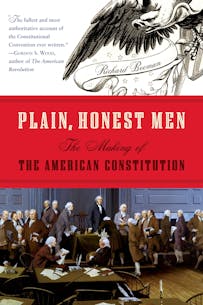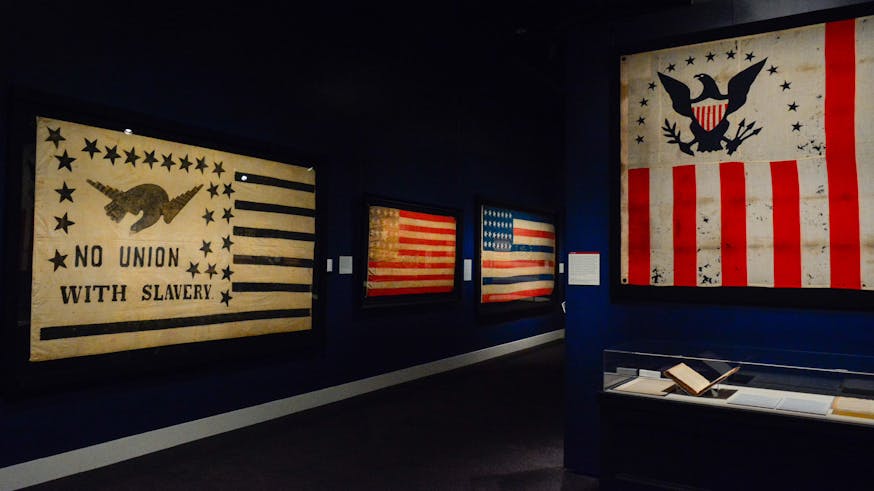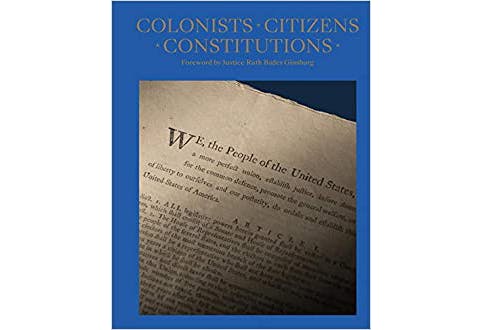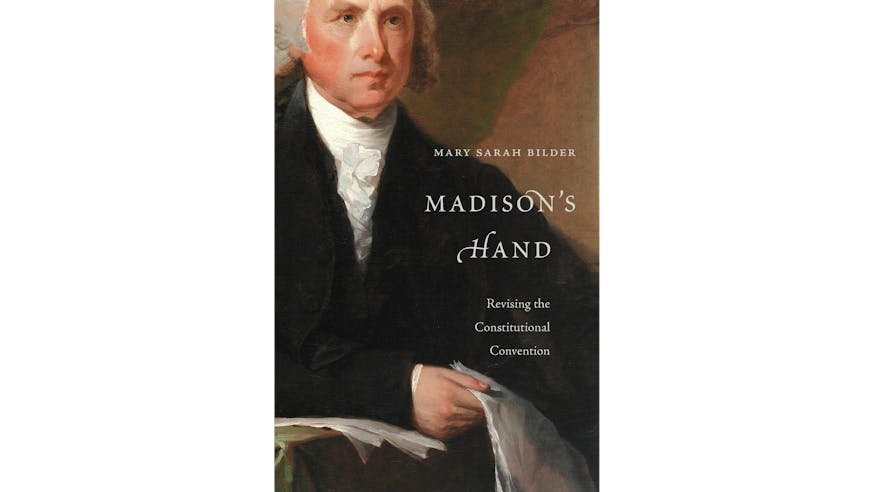Read the Revolution
Plain, Honest Men
July 28, 2021
Purchase the book from Penguin Random House.
In a recent online program hosted by the Museum, author and curator of Founding Documents Dr. James F. Hrdlicka recommended the work of the late Dr. Richard R. Beeman, who taught at University of Pennsylvania for over 40 years and was instrumental in creating exhibitions for the National Constitution Center in Philadelphia when it opened in 2003. In Plain, Honest Men: The Making of the American Constitution, winner of the George Washington Book Prize and the Literary Award of the Philadelphia Athenaeum, Beeman shares Pennsylvania delegate Gouverneur Morris’s reaction against an American tendency, even in the 1800s, to make the delegates to the Constitutional Convention larger than life. Citing initial inspiration from reading Catherine Drinker Bowen’s award-winning history, Miracle at Philadelphia, as a graduate student, Beeman takes readers to the Assembly Room at the Pennsylvania State House to meet 55 extraordinary men on an “earthly” level. Distinguished for separate qualifications in experience, education, and economic interests, these men wrote what they called the “Federal Constitution.” Meeting from May 25 to Sept. 17, 1787, (with only Sundays off) at the Constitutional Convention, these individuals effected a revolution in the nature of American government, Beeman argues.
How did the revolutionary state constitutions, and the men who wrote them, influence proceedings of the Constitutional Convention and final words of the resulting Federal Constitution? With the opportunity to reflect on many founding documents including Articles of Confederation in 1777, state constitutions became primary models for what was penned in Philadelphia 10 years later. From July 27 to Aug. 5, 1787, five delegates appointed to the Committee of Detail worked in secret to “prepare and report a Constitution” while the rest of the Convention was in recess. The subsequent Committee of Style would make additional edits in September and present the Constitution for ratification by the states.
Read two excerpts, first from Chapter 14 to learn how the Committee of Detail was influenced by state constitutions through the lens of Virginia delegate Edmund Randolph, and second from Chapter 18 to compare Randolph’s version with the Preamble we know today.
Excerpt 1
While Washington was fishing, Madison was worrying, and Gilman was gossiping, the five members of the Committee of Detail were hard at work drafting a provisional constitution. Beginning on July 27 and continuing through the weekend of August 4 and 5, the five delegates elected to the Committee of Detail sorted through all of the resolutions, amendments, qualifications, and failed proposals presented to the Convention during the previous two months and sought to bring some order to the chaos. If the committee had been vested with the power to settle any of the remaining and contested issues in the Convention, rather than as a small “board of editors,” the delegates probably would have enlarged it to include representatives from each of the states. But the committee's charge was not to plow new ground; rather they were to bring some form and shape to the ground already covered. That job, the delegates understood, could be better accomplished by a more compact group.
The divisions of the early summer seem to have played no part in the selection of the members of the Committee of Detail. Acceptance of the Connecticut Compromise by the large-state delegates had apparently made that issue a thing of the past. Of the members of the Committee of Detail, Oliver Ellsworth, for example, was the only one who came from a relatively small state (Connecticut ranked eighth overall among the thirteen in terms of population), and, as we have seen, during the previous month he had been a broker of compromise rather than a partisan defender of either small- or large-state interests. Though imbalanced in terms of state size, the membership of the Committee of Detail did display a rough geographical balance, with Nathaniel Gorham representing northern New England, Ellsworth representing lower New England, James Wilson representing the middle states, Edmund Randolph representing the upper South, and John Rutledge representing the lower South. With the large-state small-state division out of the way, it was becoming increasingly clear that differing sectional and regional interests were likely to be the greatest impediment to consensus, so it is likely that a concern for geographical balance did play a role in the election of committee members.
Certainly there were others serving in the Convention whose talents as constitutional theorists and draftsmen were at least as impressive as those of Gorham, Ellsworth, Wilson, Randolph, and Rutledge. Madison, Gouverneur Morris, Alexander Hamilton, and, perhaps, Charles Pinckney come to mind. But one can also think of reasons why those individuals might have been passed over…
[…]
As the Committee of Detail began its work on the morning of Friday, July 27, its five members knew that they faced certain challenges — chief among them those relating to the executive branch — that could not be resolved by skillful editing alone. Moreover, there was one other issue lurking in the wings. On the day the Convention formally agreed to appoint the Committee of Detail, Charles Cotesworth Pinckney rose to warn the Northern delegates that if there were any shenanigans in the committee that might serve to threaten Southern interests, the consequences would be severe. General Pinckney left no doubt as to the subject most on his mind. “If the Committee should fail to insert some security to the Southern states against an emancipation of slaves, and taxes on exports, I will be bound by duty to my state to vote against their report.” Pinckney had no reason for concern on the first score, for the very nature of the part-national, part-federal compact the framers were crafting would leave the fate of slaves entirely in the hands of those states that permitted the institution. But Pinckney's concern about taxes on exports and, more important, about other central government uses of the commerce power to weaken the institution of slavery would prove to become sources of contention after the Committee of Detail made its report.
The primary basis on which the Committee of Detail carried out its work was the amended set of resolutions first introduced by Edmund Randolph as part of the Virginia Plan, but the committee was also instructed to take into account the much-neglected “propositions submitted to the Convention by Mr. C. Pinckney,” as well as any appropriate parts of the New Jersey Plan presented in mid-June by William Paterson. Although the effort at pulling all of these disparate strands together was a collective one, Edmund Randolph was given the task of producing a rough draft for the committee's perusal. Randolph's skills as a constitutional draftsman were probably not equal to those of Wilson, and perhaps a few others on the committee, but it is not difficult to see why he was chosen to make a first pass at producing a compendium of the delegates’ work. He was, after all, the person who first introduced the Virginia Plan to the Convention. And the set of resolutions composing that plan, which most delegates referred to as the Randolph Resolutions, had formed the primary focus of discussion for the previous two months.
As he set about producing that initial draft, Randolph laid down two principles that, while they never appeared in the final report of the committee, seem extraordinary in their wisdom and foresight more than two centuries later. They were
- to insert essential principle only, lest the operations of government should be clogged by rendering those provisions permanent and unalterable, which ought to be accommodated to times and events, and
- to use simple and precise language, and general propositions, according to the example of the constitutions of the several states. (For the construction of a constitution of necessarily [sic] differs from that of law).
One cannot help but be impressed by the extent to which the framers remained true to those two principles, which in a sense contain the essential divide in contemporary constitutional debates. The first of his principles gives support to the arguments of contemporary jurists and constitutional scholars who argue that ours is a “living constitution” that must be interpreted in the light of changing times and circumstances. The second of Randolph's principles speaks to those contemporary jurists and scholars who argue for an “originalist” interpretation of our Constitution, claiming that the only way to remain true to the vision of the Founding Fathers is to interpret the precise words of the Constitution in the manner in which they would have been understood by eighteenth-century Americans. Of the two principles, however, the second would prove much more difficult to uphold. It was one thing to aspire to “simple and precise language,” but, as the delegates continued to disagree about both the substance and the subtleties of much of the constitutional language they were drafting, the “simple meaning” of their words — to use a phrase much admired by the proponents of originalism — would often prove confounding.
The other notable aspect of Randolph's approach to the task of constitution writing was his insistence that a lengthy preamble similar to that contained in the Declaration of Independence was not necessary. He considered the Constitution to be a legal, rather than a philosophical, document, and by his reasoning, “a preamble seems proper not for the purpose of designing the ends of government and human polities.” Randolph believed that elaborate displays of theory, though perhaps necessary in the drafting of the state constitutions, were inappropriate to the task now at hand. For Randolph, the business of constitution making was not an excursion back to fundamental principles or an articulation of the natural rights of man. Rather, it was a matter of taking those fundamental principles and natural rights already articulated in the Revolutionary state constitutions and interweaving them with the delegated powers written into a federal constitution. If there were to be any preamble at all, he argued, then it should confine itself to a brief declaration of why the Confederation government was insufficient and an assertion of the necessity of having a “supreme legislative, executive and judiciary.” Although what we call the “preamble” to our present United States Constitution went through several different transformations between the time Randolph expressed his views in his draft of the Report of the Committee of Detail and the closing day of the Convention, in the end, the framers of the Constitution supported Randolph's fundamental premise. The preamble to the committee's report began prosaically.
We the people of the States of New Hampshire, Massachusetts, Rhode Island and Providence Plantations, Connecticut, New-York, New-Jersey, Pennsylvania, Delaware, Maryland, Virginia, North-Carolina, South-Carolina, and Georgia, do ordain, declare and establish the following Constitution for the Government of Ourselves and our Posterity.
Sign Up!
Get biweekly Read the Revolution featured excerpts right to your inbox.
Excerpt 2
From September 13 through September 15 the delegates reviewed the Report of the Committee of Style. Although Morris and his fellow committee members had not substantially reduced the number of words in their document, they had taken the twenty-three articles in the Committee of Detail report and, by combining and editing, reduced the total number to seven more artfully worded articles.
The draft constitution, as it emerged from the Committee of Style, brought clearly into view the important differences between the proposed new federal Constitution and both the state constitutions and the Articles of Confederation. The men who drafted the Revolutionary state constitutions had intended them not only to replace the old colonial charters, but also to serve as Revolutionary manifestos explicitly announcing the separation of each state from the mother country. Most important, the structure of those state constitutions had reflected Americans’ intense fear of monarchical power. Concerns about checks and balances and separation of powers seemed far less important to the state constitution makers than the need to limit executive power. As a consequence, most of the state constitutions, with the exception of that of Massachusetts, were heavily weighted toward legislative power, rendering the executive and judicial branches distinctly subordinate to the legislative branch.
The new Constitution's contrast with the Articles of Confederation was even more striking. At best, a league of friendship among independent and sovereign states, the Articles of Confederation made it clear that “each state retains its sovereignty, freedom, and independence, and every power, jurisdiction, which is not by this Confederation expressly delegated to the United States, in Congress assembled.” With that concession to the sovereign power of the states, there was little need to devote much attention to questions relating to the balance of power between the state and continental governments. Similarly, there was little need to devote much attention to the question of the separation of powers within the Confederation government, for nearly all of the power within that government was given to a Congress in which each sovereign state was to have an equal vote.
One of the most important changes in the version of the Constitution produced by the Committee of Style occurred right up front. Whereas the Committee of Detail report had begun with a brief preamble announcing that “we the people of the states of New Hampshire , Massachusetts , Rhode Island and Providence Plantation, Connecticut, New-York, New-Jersey, Pennsylvania, Delaware, Maryland, Virginia, North-Carolina, South-Carolina, and Georgia do ordain, declare and establish the following Constitution,” the Committee of Style report contained a lengthier preamble, but a more concise and powerful definition of the source of the document's legitimacy.
We the People of the United States, in order to form a more perfect union, to establish justice, insure domestic tranquility provide for the common defence, promote the general welfare, and secure the blessing of liberty to ourselves and to our posterity, do ordain and establish this Constitution for the United States of America.
That preamble, almost certainly written by Gouverneur Morris, came as close to literary elegance as the Constitution would achieve. But the importance of the preamble extended well beyond matters of style. The deliberate omission of the mention of the individual states would have a profound effect in subsequent interpretations of the power of the federal government vis-à-vis that of the state governments. Whereas the Committee of Detail report placed authority for establishing the new government in the hands of the people of the individual states, the Committee of Style report placed that authority in the hands of “the people of the United States.” It was a fine point perhaps, but it was the point on which the constitutional argument leading to the Civil War would turn. Was this a government created by people acting in their capacity as citizens of the individual states, or was it created by people acting in their capacity as citizens of a new entity, a nation called the United States? The preamble to the Articles of Confederation made it clear that the states retained sovereign power. The preamble in the Committee of Detail report suggested that it was the people, acting through the agency of their respective states, who possessed sovereign power. Gouverneur Morris's preamble, though not definitive in its articulation, seemed to suggest that the people of the nation possessed that sovereign power. It is likely that not all of the Convention delegates understood the meaning of the phrase in that way, but it was certainly the way in which nationalists like Morris, Madison, and James Wilson wished for it to be understood.
Richard Beeman, Plain, Honest Men: The Making of the American Constitution (Random House, 2009), pages 327-337 and 424-426.
Read the Revolution is sponsored by The Haverford Trust Company.
Read the Revolution is published biweekly by the Museum of the American Revolution to inspire learning about the history of the American Revolution and its ongoing relevance.
Tags
Learn More

Flags and Founding Documents, 1776-Today
June 12 - September 6, 2021
Colonists, Citizens, Constitutions


